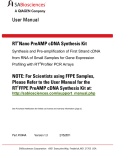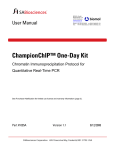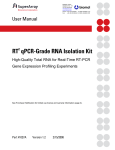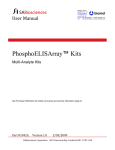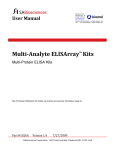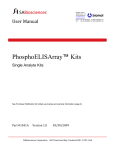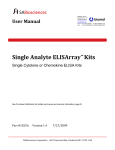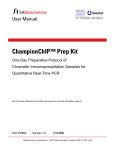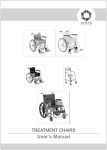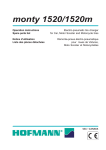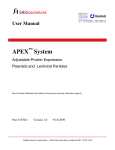Download User Manual - Biomol GmbH
Transcript
BIOMOL GmbH Waidmannstr. 35 22769 Hamburg [email protected] www.biomol.de Phone:+49-40-8532600 or 0800-2466651 (D) Fax: +49-40-85326022 or 0800-2466652 (D) User Manual RT2 qPCR-Grade miRNA Isolation Kit High-Quality Small RNA for Real-Time RT-PCR miRNA Expression Profiling Experiments See Purchaser Notification for limited use license and warranty information (page 3). Part #1033A Version 1.1 6/6/2008 2 RT qPCR-Grade miRNA Isolation Kit High-Quality Small RNA for Real-Time RT-PCR miRNA Expression Profiling Experiments User Manual (For Catalog Number: MA-01) Ordering and Technical Service Contact Information: • • • • Tel: Fax: On-line Order: E-MAIL: 1-888-503-3187 (US) 301-682-9200 (outside US) 1-888-465-9859 (US) 301-682-7300 (outside US) www.SABiosciences.com [email protected] (to place an order) [email protected] (for technical support) You may place orders by fax, e-mail or from our website. Each order should include the following information: • • • • • Your contact information (name, phone, email address) Product name, catalog number and quantity Purchase order number or credit card information (Visa or MasterCard) Shipping address Billing address For more information, visit us at www.SABiosciences.com BIOMOL GmbH Waidmannstr. 35 22769 Hamburg [email protected] www.biomol.de Phone:+49-40-8532600 or 0800-2466651 (D) Fax: +49-40-85326022 or 0800-2466652 (D) SABiosciences Corporation 6951 Executive Way Frederick, MD 21703 USA CONTENTS I. Background and Introduction 4 II. Materials Provided 5 III. Additional Materials Required 5 IV. Protocol 6 A. Sample Preparation 6 B. Small RNA Enrichment 7 C. Quality Control 9 V. Troubleshooting 10 Appendix: Recovering Large Total RNA 11 LIMITED PRODUCT WARRANTY This product is intended for research purposes only and is not intended for drug or diagnostic purposes or for human use. This warranty limits our liability to replace this product in the event the product fails to perform due to any manufacturing defect. SABiosciences Corporation makes no other warranties of any kind, expressed or implied, including without limitation, warranties of merchantability or fitness for a particular purpose. SABiosciences Corporation shall not be liable for any direct, indirect, consequential or incidental damages arising out of the use, the results of use or the inability to use this product. NOTICE TO PURCHASER 2 The purchase of the RT qPCR-Grade miRNA Isolation Kit includes a limited, nonexclusive license to use the kit components for research use only. This license does not grant rights to use any kit component for reproduction of or modification for resale or to use the RT2 qPCR-Grade miRNA Isolation Kit to manufacture commercial products without written approval of SABiosciences Corporation. No other license, expressed, implied or by estoppels, is granted. 2 RT qPCR-Grade RNA Isolation Kit I. Background and Introduction MicroRNA (miRNA) are a class of naturally occurring small RNA molecules, generally 17 to 30 nucleotides long, processed from much larger stem-loop structures (pri-miRNA and pre-miRNA). They regulate the expression of target mRNA transcripts having similar sequences via the RNA-Induced Silencing Complex (RISC). Researchers are currently correlating miRNA expression profiles to biological phenotypes in attempts to better understand miRNA-based gene regulation. Real-time, reverse transcription PCR, or qRTPCR, is the most sensitive and reliable method for nucleic acid expression analysis. However, the most important criteria for achieving accurate and sensitive real-time RTPCR analyses is the quality of the input RNA starting material. As with isolating mRNA for gene expression analysis, many common impurities found in RNA preparations interfere with the enzymes in the reverse transcription reaction resulting in low cDNA yield and poor RT-PCR sensitivity. More specifically, primary miRNA transcripts and other larger RNA molecules (rRNA, tRNA and mRNA) non-specifically interact with miRNA-specific primers sequestering them from the reaction and causing secondary product amplification that interferes with real-time PCR analysis. The RT2 qPCR-Grade miRNA Isolation Kit is optimized for real-time RT-PCR based miRNA expression analysis by enriching small RNA from a total RNA preparation. Starting with cultured cells or animal tissues in combination with a phenol/chloroform-based extraction method, the two-column protocol prepares up to 10 µg of high-quality small RNA free of genomic DNA, large RNA, and other impurities. The special silica membrane spin column technology, with appropriate ethanol concentrations, permits small RNA (< 200 nt) to flow-through an initial column, while longer RNA and DNA bind. Upon re-adjusting the ethanol concentration in the eluate, a second equivalent column optimally retains the small RNA. Washing the second column removes salts, metabolites, and other macromolecular cellular components. Low ionic strength conditions finally elute pure small RNA ready for subsequent miRNA expression analysis with the complete RT² miRNA qPCR Assay System. Large mRNA and rRNA may also be recovered from the first column for gene expression analysis, if desired. The RT² qPCRGrade™ miRNA Isolation Kit provides an easy and efficient approach to acquire miRNA of a greater purity and higher yield. The protocol takes only 60 minutes of hands-on time, and the kit includes sufficient materials to purify 12 RNA samples. 2 Benefits of the RT qPCR-Grade miRNA isolation Kit: • High Quality and High Yield: Isolate enough high-quality miRNA from cells and tissues with a protocol optimized for real-time RT-PCR expression analysis • Reliable and Sensitive: Find more miRNA sequenes expressed at lower levels while eliminating false positives • Fast and Convenient: Go from as many as 12 samples to purified miRNA with less than 60 minutes of hands-on time Technical Support: [email protected] 4 www.SABiosciences.com Version 1.1 II. Materials Provided: This kit includes enough of the following reagents to isolate or enrich miRNA from 12 samples: TUBES AND CONTENTS Lysis and Binding Buffer (G6) Washing Buffer (G17: Add 10 ml ethanol before use.) RNase-free H2O Spin Columns (24) Collection Tubes (24) Elution Tubes (12) The kit is shipped at ambient temperature and should be stored at room temperature. All reagents are stable for 6 months after receipt of the kit if stored at the recommended temperature. III. Additional Materials Required: The following required supplies are not included in the kit and must be purchased from other manufacturers: TRIzol® (Invitrogen, Cat. No. 15596-026) Chloroform (for use with TRIzol®) RNase-free 1.5-ml and 2-ml microcentrifuge tubes RNase-free pipette tips 70% and 100% ethanol, molecular biology grade Micro-cuvettes and a spectrophotometer Bench-top Micro-Centrifuge Technical Support: 888.503.3187 5 301.682.9200 2 RT qPCR-Grade RNA Isolation Kit IV. Protocol: NOTE: Washing Buffer (G17) is supplied as a concentrate. Before using for the first time, add 10 ml of 100% ethanol to make the final working solution. A. Sample Preparation 1. Directly from Cells or Tissues: Start a total RNA isolation procedure from tissue samples or cell pellets with the phenol/chloroform-based extraction TRIzol® method from Invitrogen. The brief protocol below is meant for experienced users only. First time users should read the original manufacturer’s instructions. a. Recommended homogenization method for tissue sample: i. Add 1 ml TRIzol® (not supplied) to 50-100 mg tissue. ii. Homogenize tissue with a glass-teflon or a power homogenizer. b. Alternative homogenization method for tissue sample: i. Snap-freeze tissue in liquid nitrogen. ii. Grind into a powder using a mortar and pestle in liquid nitrogen. iii. Transfer tissue powder to a 2-ml RNase-free microcentrifuge tube. iv. Allow liquid nitrogen to evaporate, but do not allow the tissue to thaw. v. Add 1 ml TRIzol® to tissue powder and mix vigorously. NOTE: The TRIzol® reagent volume must be at least ten-times the tissue sample volume. NOTE: Processing a larger amount of some tissues (> 10 mg) may require further lysate homogenization through a 20 gauge needle and syringe before proceeding. c. d. e. f. g. Cell pellets (up to 5 x 106 each) can be lysed by resuspension in 1ml TRIzol®. Let the lysate stand at room temperature for 5 min. Add 200 μl of chloroform to the sample and mix vigorously. Centrifuge for 5 min at 12,000 x g at 4 °C. Transfer 400 μL upper aqueous phase to a fresh tube. 2. From Previously Isolated Total RNA: a. Total RNA samples MUST have been isolated using a TRIzol® extraction and isopropanol precipitation procedure as described above. NOTE: Total RNA isolated from most column-based methods and protocols do not contain small RNA for enrichment. For details, so the Troubleshooting Guide or contact a Technical Support representative. b. Start with 10 to 40 μg total RNA in no more than a 40 μL-volume. Less total RNA will not be sufficient for the miRNA PCR Arrays More total RNA will overload the column. c. Add enough G6 to bring each total RNA sample to a final volume of 400 μL. Technical Support: [email protected] 6 www.SABiosciences.com Version 1.1 B. Small RNA Enrichment: 1. Adjust RNA Binding Conditions: a. Add 215 µL of 100% ethanol to each 400-μL sample. b. Mix well by pipetting up-and-down five (5) times or by vortexing gently. 2. Remove Large RNA from Sample: a. Remove the FIRST set of Spin Columns already in their own Collection Tubes from their packaging. b. Add each sample now mixed with ethanol to the center of its own Spin Column. c. Centrifuge for 30 s at 11,000× g. d. Remove Spin Columns from the Collection Tubes. Eluates contain small RNA. Save the Collection Tubes and their eluates. If you are not also isolating mRNA, discard the Spin Columns. NOTE: If you would also like to isolate the larger, total RNA (or mRNA) portion of the same experimental samples, save the Spin Columns and the follow the protocol in the Appendix of this User Manual. 3. Bind Small RNA to Second Spin Column: a. Add 750 µL of 100% ethanol to the saved eluates in their Collection Tubes. b. Mix well by pipetting up-and-down five (5) times. c. Remove the SECOND set of Spin Columns from the packaging. d. Add 700 μL from each ethanol mixture to the center of its own Spin Column. e. Centrifuge for 30 s at 11,000× g. f. Remove Spin Columns from Collection Tubes. Discard flow-through material. Place Spin Columns back into the same Collection Tubes. g. Add the remaining of the ethanol mixture to the center of the SAME Spin Column. h. Centrifuge for 30 s at 11,000× g. i. Remove Spin Columns from Collection Tubes. Discard flow-through material. Place Spin Columns back into same Collection Tubes. Technical Support: 888.503.3187 7 301.682.9200 2 RT qPCR-Grade RNA Isolation Kit 4. First Wash of Second Spin Column: NOTE: Just before the first use, add 10 ml of 100% ethanol to the Washing Buffer (G17) to make the Washing Buffer working solution (G17 plus ethanol). a. Add 200 µL of Washing Buffer working solution to each Spin Column. Washing Buffer working solution = G17 plus ethanol b. Centrifuge for 30 s at 11,000 x g. c. Remove Spin Columns from Collection Tubes. Discard flow-through material. Place Spin Columns back into Collection Tubes. 5. Second Wash of Second Spin Column Wash: a. Add 250 µL of 70% ethanol to each Spin Column. b. Centrifuge for 3 min at 11,000 x g to dry the Spin Columns completely. NOTE: If the column outlet comes into contact with the flow-through for any reason during any wash, discard the flow-through and centrifuge again for 30 s at 11,000 x g. c. Transfer Spin Columns from Collection Tubes to Elution Tubes. Discard Collection Tubes. 6. Elute Small RNA from Second Spin Column: a. Add 40 µL RNase-free H2O to each Spin Column. b. Allow Spin Columns to stand for 1 min at room temperature. c. Centrifuge for 1 min at 11,000 x g. d. Eluate contains enriched small RNA sample. Discard Spin Columns. Technical Support: [email protected] 8 www.SABiosciences.com Version 1.1 C. Quality Control: 1. Quantification: a. Dispense 49 μL 10 mM Tris pH 8.0 into UV transparent microcuvette ensuring that there are no bubbles in the light path. b. Place the cuvette into the UV spectrophotometer and blank the instrument. c. Without removing the cuvette from the instrument, add 1 μL RNA sample and gently mix the cuvette contents with the pipet tip. d. Read and record the absorbance at 230, 260 & 280 nm. e. Remove the cuvette, dispose of the contents, then rinse and dry the cuvette. f. Determine sample purity by calculating 260/280 and 260/230 ratios. Clean samples will have ratios greater than or equal to the values listed below. i. 260/230 for RNA > 1.7 (A low 260/230 ratio indicates possible salt or guanidine contamination.) ii. 260/280 for RNA > 2.0 (A low 260/280 ratio indicates possible protein contamination.) g. Calculate the concentration: A260 x 40 x 50 (Dilution Factor) = Sample Conc. μg/mL (or ng/μL) h. Repeat quantification for each RNA sample. NOTE: If using a NanoDrop spectrophotometer, mix 1 μL of RNA sample with 1 μL of 10 mM Tris pH 8.0, and read the absorbance at all three wavelengths according to the instructions from the instrument manufacturer. Remember that a dilution factor two (2) has been introduced when calculating your concentration. 2. Expected Yields: Small RNA is typical one-tenth of the total RNA sample. For example, enriching 1 μg of total RNA with this kit typically yields of around 100ng of small RNA. 3. RNA Quality: Characterize ~ 10 ng of the small RNA on an Agilent Bioanalyzer using an RNA 6000 Nano LabChip®. The RNA should contain a single sharp peak at a low molecular weight with no smearing and no additional peaks at higher molecular weights. 4. Store RNA at -20 °C for 2-4 days or at -80 °C for up to six months. Technical Support: 888.503.3187 9 301.682.9200 2 RT qPCR-Grade RNA Isolation Kit V. Troubleshooting: For technical support, please call us at 888-503-3187 or 301-682-9200. Technical Support: [email protected] 10 www.SABiosciences.com Version 1.1 Appendix: Recovering Large Total RNA 1. First Wash of First Spin Column: NOTE: Just before the first use, add 10 ml of 100% ethanol to the Washing Buffer (G17) to make the Washing Buffer working solution (G17 plus ethanol). a. Add 200 µL of Washing Buffer working solution (G17 plus ethanol) to each Spin Column. Use the Original Collection Tube b. Centrifuge for 30 s at 11,000 x g. c. Remove Spin Columns from Collection Tubes. Discard flow-through material. Place Spin Columns back into Collection Tubes. 2. Second Wash of First Spin Column: a. Add 250 µL of 70% ethanol to each Spin Column. b. Centrifuge for 3 min at 11,000 x g to dry the Spin Columns completely. NOTE: If the column outlet comes into contact with the flow-through for any reason during any wash, discard the flow-through and centrifuge again for 30 s at 11,000 x g. c. Transfer Spin Columns from Collection Tubes to RNAse-free 1.5-ml tubes. Discard Collection Tubes. 3. Elute Large Total RNA (mRNA) from First Spin Column: a. b. c. d. Add 40 µL RNase-free H2O to each Spin Column. Allow Spin Columns to sit for 1 min at room temperature. Centrifuge for 1 min at 11,000 x g. Eluate contains enriched small RNA sample. Discard Spin Columns. 4. DNAse-Treatment: Follow the TURBO DNA-free™ kit (Ambion, AM1907) manufacturer’s instructions. 5. Quality Control: a. Quantification: Follow the same instructions above as for small RNA. b. RNA Quality: Electrophorese a fraction of each RNA sample on a denaturing agarose gel or on an Agilent BioAnalyzer using an RNA 6000 Nano LabChip® and verify that there is a sharp distinction at the small side of both the 18S and 28S ribosomal RNA (rRNA) bands or peaks. Any smearing or shoulder to the rRNA bands or peaks indicates that degradation has occurred in the RNA sample. c. Storage: Store RNA at -20 °C for 2-4 days or at -80 C for up to six months. Technical Support: 888.503.3187 11 301.682.9200 RT2 qPCR-Grade miRNA Isolation Kit User Manual Part #1033A Version 1.1 6/6/2008 BIOMOL GmbH Waidmannstr. 35 22769 Hamburg [email protected] www.biomol.de Phone:+49-40-8532600 or 0800-2466651 (D) Fax: +49-40-85326022 or 0800-2466652 (D)












